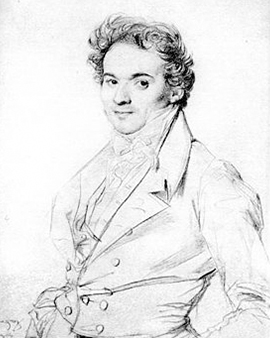Jean Alaux, known as "le Romain" (the Roman), was born January 15, 1786 and died March 2, 1864. He was a French history painter and director of the French Academy in Rome from 1846 to 1852.
Born in Bordeaux, the son of a painter and second of four brothers who all became painters, Alaux received his first art lessons from his father. He then trained formally at Pierre Lacour and later at Baron Pierre Narcisse Guerin. In 1807 he was accepted at the École des Beaux-Arts in Paris. Beginning in 1808, he submitted works for the Prix de Rome, but his attention was diverted when his older brother Francois Alaux asked him to help with a large "neorama" (a type of panorama) he was working on. Finally, in 1815, Alaux won the Grand Prix de Rome with a work called "Brisei's Weeping over the Body of Patroclus," a scene inspired by Homer's Iliad. He was then a pensioner at the French Academy in Rome from 1816 to 1820 and later became its director.
His fellow artists at the Academy included Drölling, Picot, and Cogniet, as well as the sculptors d'Angers, Pradier, and Ramey. He became a friend of Ingres. His first painting at the Academy was "Cadmus Killing the Dragon at the Fountains of Dirce," which was later purchased by the Duke of Orleans but destroyed in the fire that devastated the Palais-Royal in the French Revolution of 1848. Other works he painted at the Academy included "Diamedes Abducting the Palladium" and "Episodes in the Battles between the Centaurs and the Lapiths." In 1821 he returned to France, where his reputation grew steadily with works such as "The Baptism of Clovis" (1825), "The States General of 1838," "The Assembly of the Notables at Rouen" of 1596, and "The States General of 1614."
Under the July Monarchy, he worked in the "Galerie des batailles" of the Palace of Versailles, for which he painted The Battle of Villaviciosa (1836), The Capture of Valenciennes (1837), and The Battle of Denain (1839). In 1846 Alaux was appointed director of the French Academy in Rome. He and his students had to temporarily flee the city for France during the siege of Rome in 1849, which involved the defending Italian forces under Garibaldi and the invading French army. His tenure as director ended quietly with his retirement in 1852.
×





_on_17031677_Vauban_directs_the_mil_-_(MeisterDrucke-946323).jpg)
_on_17031677_Vauban_directs_the_mil_-_(MeisterDrucke-946323).jpg)
.jpg)
.jpg)
.jpg)
.jpg)
.jpg)
.jpg)
.jpg)
.jpg)
.jpg)
.jpg)
.jpg)
.jpg)
.jpg)
.jpg)
_the_Stubborn_King_of_Navarre_Enfranchising_the_Serfs_3rd_Jul_-_(MeisterDrucke-1128497).jpg)
_the_Stubborn_King_of_Navarre_Enfranchising_the_Serfs_3rd_Jul_-_(MeisterDrucke-1128497).jpg)
 - (MeisterDrucke-82862).jpg)
 - (MeisterDrucke-82862).jpg)
.jpg)
.jpg)
.jpg)
.jpg)
.jpg)
.jpg)
 copy of a portrait by Thomas Lawrence (1769-1830) - (MeisterDrucke-73085).jpg)
 copy of a portrait by Thomas Lawrence (1769-1830) - (MeisterDrucke-73085).jpg)
.jpg)
.jpg)
.jpg)
.jpg)
.jpg)
.jpg)
.jpg)
.jpg)
.jpg)
.jpg)
.jpg)
.jpg)
.jpg)
.jpg)
.jpg)
.jpg)
.jpg)
.jpg)
.jpg)
.jpg)
.jpg)
.jpg)
.jpg)
.jpg)
.jpg)
.jpg)
.jpg)
.jpg)
.jpg)
.jpg)
.jpg)
.jpg)
.jpg)
.jpg)
.jpg)
.jpg)
 - (MeisterDrucke-134395).jpg)
 - (MeisterDrucke-134395).jpg)
.jpg)
.jpg)
_marchal_de_Franc_-_(MeisterDrucke-1572925).jpg)
_marchal_de_Franc_-_(MeisterDrucke-1572925).jpg)
_receiving_King_Louis-Philippe_1st_(1773-1850)_as_knig_-_(MeisterDrucke-960776).jpg)
_receiving_King_Louis-Philippe_1st_(1773-1850)_as_knig_-_(MeisterDrucke-960776).jpg)
.jpg)
.jpg)
.jpg)
.jpg)






